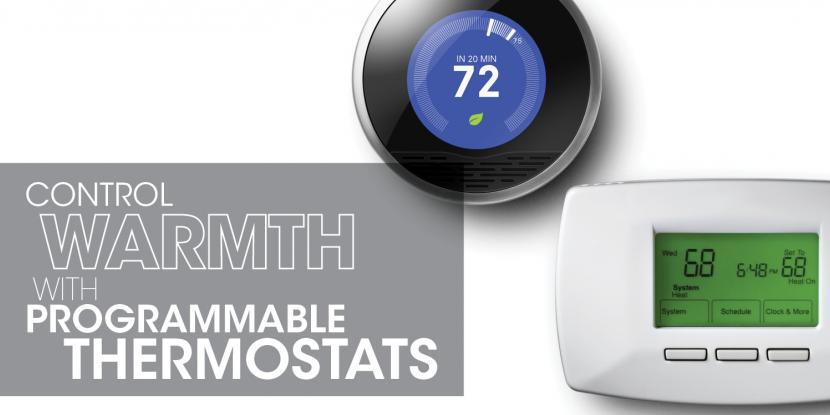Control Warmth in Your Home with a Programmable Thermostat

If you’re looking for an easy way to improve home comfort and energy efficiency this winter, consider upgrading your thermostat to a programmable version. The ability to program temperature changes lets you maximize energy savings while you’re asleep at night and at work during the day without sacrificing comfort. Use these tips to select and set up your programmable thermostat for complete temperature control this winter.
How to Select a Programmable Thermostat
Consider Your Programming Options
You have four primary programming settings to choose from:
- 1-week programming is the least flexibly option. The daily setting applies to every day of the week.
- 5-2 day programming allows you to program the weekdays and the weekends independently of each other.
- 5-1-1 day programming gives you the added flexibility of programming Saturday and Sunday differently.
- 7-day programming is the most flexible option, allowing you to program each day uniquely.
Pick Advanced Features
While a basic programmable thermostat may deliver everything you want, it may be nice to have access to features that are particularly useful for you. For example:
- A keyboard lock feature is useful if you have children who like to tamper with settings.
- Indicator lights tell you when to change the battery and filter.
- A touch screen and back-lit display improve ease-of-use.
- Vacation mode allows you to save energy while you’re away and return to regular settings with the touch of a button.
- Wi-Fi capability lets you control your thermostat from anywhere with your Smartphone.
How to Set a Programmable Thermostat
Programmable thermostats are proven energy savers, but your upgrade will only lower your energy bills if you know how to use it correctly. Follow these tips to maximize the usefulness of your new programmable thermostat:
- Use energy-saving setbacks: These are most beneficial if they last at least eight hours at a time. The best times for setbacks are during the day while you’re away at work and at night when everyone is asleep. By programming timely recovery periods, you avoid returning home or waking up to a freezing house. Remember, the longer each setback period is and the further you set the temperature back, the more you’ll save.
- Use overrides sparingly: Every programmable thermostat lets you temporarily change the setting if you get too hot or cold. The override is canceled when the next preprogrammed period arrives. The more you override settings, the more you end up paying to heat your home. Before you change the temperature, put on a sweater to help you warm up.
- Change the temperature by only a degree or two: When you do decide to override the setting, don’t crank the programmable thermostat way up. This doesn’t heat your home any faster and only stands to waste energy.
- Use the correct override feature: You typically have two override features to choose from: a temporary hold and a vacation/permanent hold. Use the temporary hold for day-to-day overrides and the permanent hold when you’re gone for days at a time. This latter override feature doesn’t resume the regularly scheduled program automatically, allowing you to save when you’re gone on vacation.
- Consider zoning: This utilizes multiple thermostats throughout your home to achieve a comfortable temperature in every room. If you have comfort problems or different needs for various rooms, consider adding a zoning system.
- Change the batteries: Make it a habit to change the batteries in the programmable thermostat once per year. Some units indicate when the batteries are low so you know when to change them.
To learn more about maintaining the warmth in your home, please contact Aire Serv® today.
 Click to call
Click to call


